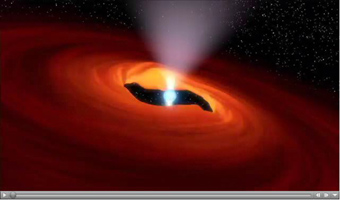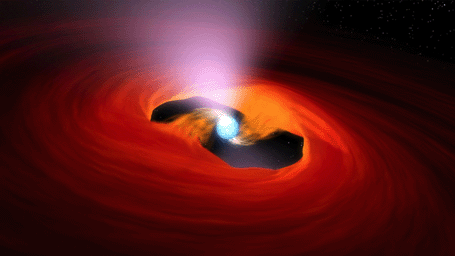
Click on the image to view the animation
Click here for the full resolution movieThis animation shows a neutron star -- the core of a star that exploded in a massive supernova. This particular neutron star is known as a pulsar because it sends out rotating beams of X-rays that sweep past Earth like lighthouse beacons. X-ray telescopes like NASA's Nuclear Spectroscopic Telescope Array, or NuSTAR, pick up these beams, registering them as pulses of X-ray light.
What causes a pulsar to pulse? In the case of "accreting pulsars," the process is set in motion when matter from a companion star falls onto the pulsar. The gravity of the pulsar pulls this material from a surrounding disk, as shown in the animation. The strong magnetic fields surrounding the pulsar funnel the infalling material onto two spots above and below the stellar core. This causes the material to heat up to extreme temperatures and release X-rays. As the star rotates, the two X-ray hot spots behave like a lamp in a lighthouse, sweeping around. Only when the "lamps" are facing Earth will NuSTAR pick up the signal -- a pulsing of X-rays.
NuSTAR is a Small Explorer mission led by the California Institute of Technology in Pasadena and managed by NASA's Jet Propulsion Laboratory, also in Pasadena, for NASA's Science Mission Directorate in Washington. The spacecraft was built by Orbital Sciences Corporation, Dulles, Virginia. Its instrument was built by a consortium including Caltech; JPL; the University of California, Berkeley; Columbia University, New York; NASA's Goddard Space Flight Center, Greenbelt, Maryland; the Danish Technical University in Denmark; Lawrence Livermore National Laboratory, Livermore, California; ATK Aerospace Systems, Goleta, California, and with support from the Italian Space Agency (ASI) Science Data Center.
NuSTAR's mission operations center is at UC Berkeley, with the ASI providing its equatorial ground station located at Malindi, Kenya. The mission's outreach program is based at Sonoma State University, Rohnert Park, California. NASA's Explorer Program is managed by Goddard. JPL is managed by Caltech for NASA.
For more information, visit http://www.nasa.gov/nustar and http://www.nustar.caltech.edu/.

 Planetary Data System
Planetary Data System













